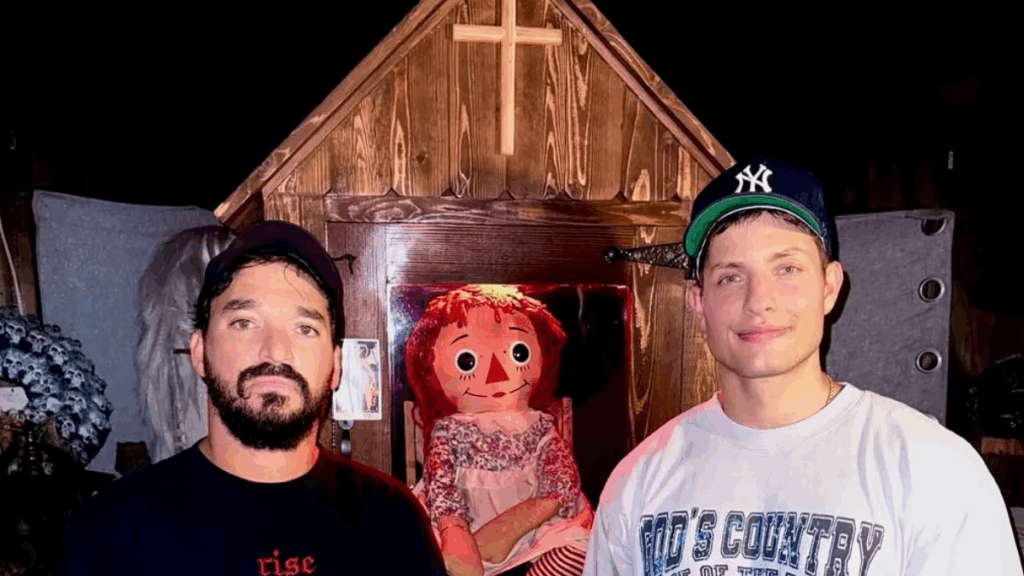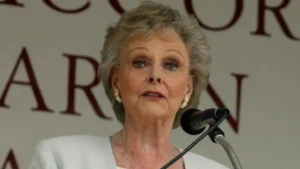Matt Rife has made a career out of quick wit, viral crowd work, and a kind of flirtatious charisma that’s more at home in comedy clubs and TikTok scrolls than haunted basements. So when news broke that the 29-year-old comic had purchased the Conjuring House — yes, the one tied to demonic possession and one of the most infamous paranormal cases in American history — the internet did a collective double-take. Was this a punchline? A prank? Or, possibly, a power move?
The answer might be a mix of all three.
In an age where celebrities are as much entrepreneurs as entertainers, Rife’s investment is more than a stunt. It’s a savvy brand expansion that taps into a cultural fascination with the eerie and unexplained — and a lucrative niche that blends horror, hospitality, and high engagement. This article dives into the strange logic behind the move: how a rising comic is turning a haunted farmhouse into a potential financial asset, cultural talking point, and maybe even a haunted content empire. Because in 2025, sometimes the best investments come with a few ghosts.
The Real Story Behind the Real Estate
From Possessions to Profits — A Brief History of the Conjuring House
Perched on a remote patch of land in Harrisville, Rhode Island, the Conjuring House looks like any other aging colonial farmhouse — until you learn what happened inside. In the early 1970s, the Perron family moved in and allegedly experienced a wave of chilling phenomena: beds shaking, disembodied voices, and shadowy figures appearing in doorways. The disturbances became so severe that famed paranormal investigators Ed and Lorraine Warren were called in, linking the house to a spirit named Bathsheba — a woman accused of witchcraft in the 19th century.
Decades later, the Perrons’ story became the chilling backbone of The Conjuring (2013), launching a billion-dollar horror franchise and immortalizing the house in pop culture. It’s not just a location — it’s intellectual property. Today, its notoriety alone makes it one of the most valuable haunted homes in the world, where history and horror go hand in hand.
Why It’s More Than a Spooky Purchase for Rife
On the surface, Matt Rife buying the Conjuring House reads like a headline crafted for clicks — comedian buys cursed house. But dig a little deeper, and the move aligns with a broader trend: entertainers leveraging cultural capital as business strategy. Rife, whose rise has been fueled by sharp crowd work and social media mastery, understands the value of staying unforgettable in an oversaturated market.
This haunted property isn’t just real estate — it’s a narrative asset. Whether he plans to film paranormal content, host immersive fan experiences, or simply lean into the internet’s obsession with the bizarre, Rife is cultivating mystique as a monetizable extension of his brand. It’s also a clever pivot from comic to cultural curator. Is it a PR stunt? Maybe. A business experiment? Likely. But it could also be deeply personal — a creative playground where humor and horror collide on his terms.
Haunted Value: Can Paranormal Properties Be Profitable?
Haunted Houses as Hospitality Assets
Haunted real estate isn’t just about thrills — it’s about returns. Take the Lizzie Borden House in Fall River, Massachusetts: once the scene of a grisly double murder, it now welcomes overnight guests at $300+ per night and rakes in hundreds of thousands annually from ghost tours and paranormal investigations. Or consider the Stanley Hotel in Colorado — the eerie inspiration for The Shining — which transformed its ghostly reputation into a thriving tourism engine, complete with “spirited” rooms and sold-out ghost hunts. In 2021 alone, it drew over 400,000 visitors.
These properties operate at the intersection of folklore and experience economy. They generate not only room revenue but also secondary streams from merchandise, documentaries, podcast features, and branded events. Unlike typical short-term rentals, haunted venues come with built-in storylines — and that narrative edge drives demand. For a celebrity like Matt Rife, owning a place like the Conjuring House isn’t just quirky. It’s potentially a content goldmine, a hospitality hook, and a long-term brand investment — all rolled into one eerie address.
Scarcity, Virality, and the Modern Brand Ecosystem
In today’s digital economy, weird sells — and scarcity drives engagement. From limited-edition Crocs to meme-worthy mansions, consumers crave the strange, the rare, and the one-of-a-kind. The Conjuring House hits all three. There’s only one property in the world tied to that movie, that legend, and that lingering cultural fear. It’s not just a house — it’s a story with walls.
Online, that story becomes a viral engine. Every creak in the floorboards or flicker in a hallway becomes potential content: TikToks, livestreams, podcasts, docuseries. And the more distinctive the setting, the more likely it is to break through algorithmic noise. In this context, haunted houses are no longer just residences — they’re experiential IP. They function as launchpads for storytelling and monetization across multiple platforms.
For someone like Matt Rife, whose brand thrives on spontaneity and spectacle, owning the Conjuring House isn’t just about owning land. It’s about controlling a narrative ecosystem — one that people are already obsessed with, and one that continues to grow with every ghost story shared.
Matt Rife’s Net Worth Playbook
Diversification or Drama? His Broader Investment Strategy
Matt Rife didn’t just blow up overnight — he built momentum from the ground up. Starting as a teenage comic grinding through open mics, Rife caught early visibility on MTV’s Wild ’N Out, but it wasn’t until his crowd work clips went viral on TikTok that his brand truly exploded. From there, the snowball effect took over: a Netflix special (Natural Selection), a sold-out world tour, and a merch empire built on edgy humor and Gen Z relatability.
Now, with millions of followers across platforms and multiple income streams humming, Rife seems to be stepping into phase two: entrepreneur. His haunted house purchase might look like a curveball, but it also signals a shift from “just” performing to owning the ecosystem. Whether he plans to launch paranormal content, experiential fan events, or a spooky Airbnb, the move reflects the same instincts that made his comedy viral — give people something they’ve never seen before. It’s unclear whether this signals a long-term investment pattern or a one-off passion project, but either way, it’s bold — and very on brand.
Haunted House ROI – A Forecast
From an investor’s lens, the Conjuring House offers a rare blend of mystique and monetization. Similar haunted properties — like the Lizzie Borden House or Ohio’s haunted Malabar Farm — generate upwards of $250,000–$500,000 annually through guided tours, overnight stays, and seasonal events. With Matt Rife’s celebrity status and digital reach, that potential only scales.
Picture this: branded “Stay the Night” ghost tours for fans, exclusive YouTube or Netflix docuseries hosted by Rife himself, limited-edition haunted merch drops, and a Halloween event calendar rivaling theme parks. Even a modestly priced livestreamed paranormal investigation could draw thousands of paying viewers — especially if infused with Rife’s signature humor.

Assuming a $1.5M purchase price and modest annual revenue of $300K from mixed streams, the property could begin breaking even within 5–6 years — faster if content partnerships or viral moments spike demand. It’s not just real estate — it’s a living narrative factory. In a media economy obsessed with novelty and niche, Rife may have just acquired the perfect content engine in ghostly disguise.
How Rife’s Net Worth Stacks Up
Matt Rife may not be the wealthiest comedian in the game, but he’s rapidly becoming one of the most talked about — and that has its kind of currency. As of 2025, Forbes estimates Rife’s fortune at around $50 million, placing him below long-established names like Kevin Hart (over $450M) but right in line with the next-gen cohort of digital-native comedians.
Compare him to Trevor Wallace, who’s built a lucrative comedy brand via YouTube and podcasting, reportedly worth $10–12 million, or Andrew Schulz, who turned his self-produced specials and Flagrant podcast into a multimillion-dollar empire (estimated ~$4M). Then there’s Theo Von, whose quirky charm and top-ranking podcast landed him national tours and growing wealth north of $5 million.
What sets Rife apart isn’t just the income — it’s the route. While many comics go all-in on media empires or comedy-adjacent ventures (merch lines, production companies, podcasts), Rife is veering left into experiential real estate. Buying the Conjuring House isn’t just a business move — it’s a branding risk with upside. It’s storytelling made tangible.
In a way, Rife is carving out a niche as comedy’s haunted showman — leveraging the spectacle economy instead of competing in the saturated podcasting arms race. He’s not just selling jokes anymore; he’s creating lore. If the gamble pays off, Rife could emerge not only as one of the most-followed comics of his generation, but one of the most creatively bankable. And that’s a ghost story Hollywood — and Wall Street — might just believe in.
What It’s Like to Own a Haunted House
I didn’t expect the silence to be the loudest part.
The night I stayed in a haunted house — not a kitschy Airbnb with fake cobwebs, but a place with a documented history of hauntings — I thought I’d be bracing for screams, bumps in the night, maybe even some theatrical wind. But what got me was how still everything felt. Too still. Like the house was holding its breath.
The floorboards groaned under my steps in a way that didn’t feel accidental. The walls seemed to listen. I slept — or tried to — under heavy blankets, half-joking to myself that they’d protect me from anything paranormal. They didn’t. Around 3 a.m., a door creaked open down the hall. No one was there. Maybe it was old wood and cold air. Or maybe not.
Owning a place like this, I imagine, is part thrill, part burden. You’re not just responsible for property taxes — you’re the keeper of a story people already believe in. And that belief carries weight. People show up hoping to feel something, to brush up against the invisible. You’re offering more than a place to stay; you’re offering them a little fear — and a little magic.
When I heard Matt Rife had bought the Conjuring House, I didn’t laugh. I got it. As someone in the spotlight, he’s built a career on presence and timing — both essential in comedy and, strangely, in hauntings. And if he’s the type who leans into discomfort, who sees mystery as an asset, then maybe he’s not just the owner of a haunted house. Maybe he’s the right kind of haunted host.
Celebrity Branding, the Paranormal Way
Haunted content is no longer just for niche horror fans — it’s become a digital playground for influencers and creators hungry for engagement. Paranormal TikTok is a booming subculture, with creators like @kelsitheghosthunter and @theghoulguide racking up millions of views for low-lit footage, EVP recordings, and shaky flashlight reveals. YouTube channels like Sam and Colby or Buzzfeed Unsolved have turned haunted investigations into episodic storytelling, pulling audiences in with cliffhangers, lore, and genuine suspense.
Matt Rife, who’s already a master of algorithmic timing thanks to his viral stand-up clips, now owns a set piece that practically begs for cross-platform content. Imagine a series where he invites other comedians or influencers to stay the night, combining horror with humor — a kind of Ghost Hunters meets Hot Ones. Or a limited-run docuseries that explores the real history of the house, filtered through his comedic lens. Even TikTok bits — short sketches where he parodies ghost-hunting tropes — could rack up millions of views with little production overhead.
The Conjuring House isn’t just an asset. It’s a storyline. And in an era where personality is platform, Rife now has both — and a ghost or two to help him tell the tale.
What This Means for Fans — And for the Industry
The Cult of Curiosity Around Celebrity Real Estate
There’s something irresistibly voyeuristic about celebrity real estate — especially when it veers into the eccentric. Whether it’s Drake’s YOLO estate complete with a private basketball court and luxury beds that cost more than most cars, or Johnny Depp’s private island in the Bahamas, fans are drawn to homes that reflect not just wealth, but persona.
These spaces become extensions of identity, and by peeking inside them — even virtually — we feel closer to the myth. It’s not just about square footage; it’s about fantasy. Owning something strange, haunted, or wildly extravagant signals individuality, mystery, or rebellion. When celebrities invest in the bizarre, fans don’t just follow — they project, imagine, and sometimes even obsess. It’s real estate as emotional theater.
Could Rife Be Setting a New Trend?
Matt Rife’s haunted home purchase might seem like an anomaly — but what if it’s the beginning of a new blueprint? In an era where content is king and narrative drives everything, creators may start seeking properties not for luxury, but for lore. Imagine YouTubers buying abandoned amusement parks, podcasters living in Cold War bunkers, or streamers broadcasting from UFO hotspots.
“Story-first” assets — places steeped in myth, history, or internet-fueled obsession — offer creators something traditional investments can’t: built-in intrigue. Rife didn’t just buy a house. He bought a plotline, a backdrop, a character in his larger brand universe. If others follow, we might be entering a new phase of influencer real estate — one where the weird, haunted, or forgotten becomes tomorrow’s digital goldmine.
From Stage Lights to Spirit Lights
Matt Rife’s purchase of the Conjuring House is more than a quirky headline — it’s a savvy collision of humor, horror, and hustle. In a world where attention is currency and stories are capital, he’s not just diversifying his portfolio; he’s deepening his narrative. This isn’t about flipping haunted real estate for a quick return. It’s about stepping into legend, owning a piece of pop culture that’s already haunted the public imagination for decades.
The real ROI might not come in dollars, but in something far rarer — mystique. In making the house part of his mythology, Rife’s building a brand with shadows and substance. And maybe that’s the genius: turning the intangible into influence.
It begs the question — if you had the chance, would you invest in the unknown? Or are some doors better left unopened?
Nishant Wagh is the founder of The Graval and a seasoned SEO and content strategist with over 15 years of experience. He writes with a focus on digital influence, authority, and long-term search visibility.





2 thoughts on “Inside Matt Rife’s Haunted Investment: How the Conjuring House Could Boost His Net Worth”